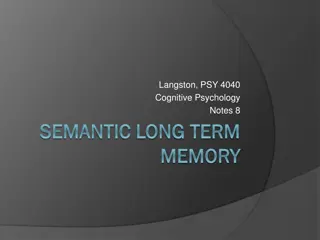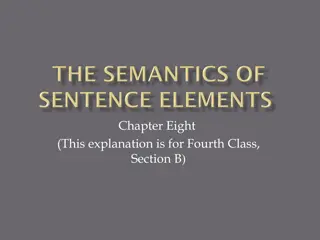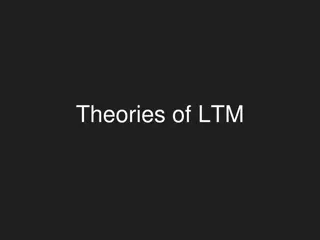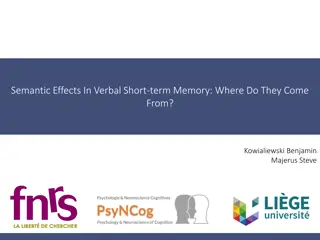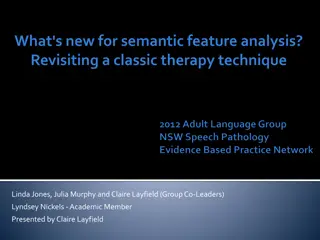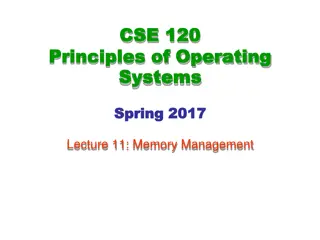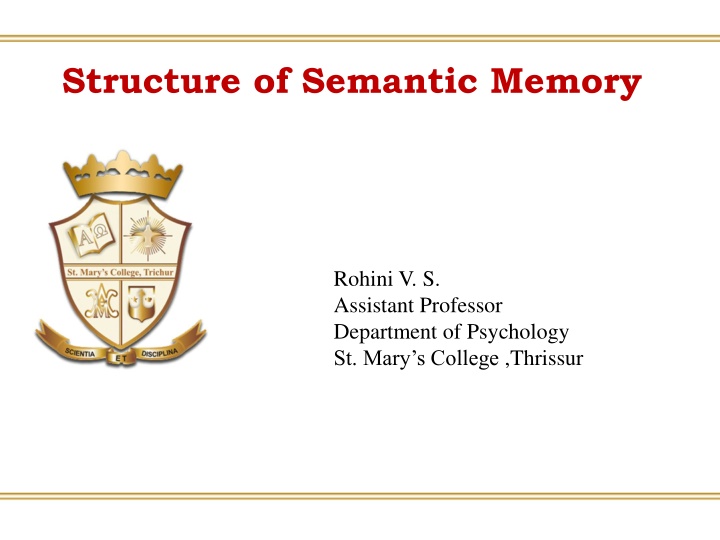
Semantic Memory: Categories, Concepts, and Models
Explore the structure of semantic memory, encompassing encyclopedic, lexical, and conceptual knowledge that influences cognitive activities. Delve into categories, concepts, and models like the Feature Comparison Model and the Prototype Approach. Discover the importance of semantic memory in decision-making, problem-solving, and language processing.
Uploaded on | 3 Views
Download Presentation

Please find below an Image/Link to download the presentation.
The content on the website is provided AS IS for your information and personal use only. It may not be sold, licensed, or shared on other websites without obtaining consent from the author. If you encounter any issues during the download, it is possible that the publisher has removed the file from their server.
You are allowed to download the files provided on this website for personal or commercial use, subject to the condition that they are used lawfully. All files are the property of their respective owners.
The content on the website is provided AS IS for your information and personal use only. It may not be sold, licensed, or shared on other websites without obtaining consent from the author.
E N D
Presentation Transcript
Structure of Semantic Memory Rohini V. S. Assistant Professor Department of Psychology St. Mary s College ,Thrissur
Background on Semantic Memory Semantic memory is our organized knowledge about the world. Semantic memory includes: o encyclopedic knowledge (e.g., Martin Luther King, Jr., was born in Atlanta, Georgia ); o lexical or language knowledge (e.g., The word justice is related to the word equality ); o conceptual knowledge (e.g., A square has four sides ). It influences most of our cognitive activities. For instance, we need this form of memory so that we can determine locations, read sentences, solve problems, and make decisions. Structure of Semantic Memory, Rohini V. S., St. Mary s College
Background on Semantic Memory Categories and concepts are essential components of semantic memory. Category Set of objects that belong together. For example, the category called fruit represents a certain category of food items; the cognitive system treats these objects as being equivalent. Concept Mental representations of a category. Eg:- Concept of fruit, which refers to your mental representation of the objects in that category. Structure of Semantic Memory, Rohini V. S., St. Mary s College
The Feature Comparison Model According to the feature comparison model, concepts are stored in memory according to a list of necessary features or characteristics. Smith and his coauthors propose that the features used in this model are either defining features or characteristic features. o Defining features are those attributes that are necessary to the meaning of the item. o For example, the defining features of a robin include that it is living and has feathers and a red breast. o Characteristic features are those attributes that are merely descriptive but are not essential. o For example, the characteristic features of a robin include that it flies, perches in trees, is not domesticated, and is small in size. Structure of Semantic Memory, Rohini V. S., St. Mary s College
The Feature Comparison Model Research on the Feature Comparison Model: Sentence verification technique. o In this technique, people see simple sentences, and they must consult their stored semantic knowledge to determine whether the sentences are true or false. (eg: A poodle is a dog, a squirrel is an animal, a flower is a rock, etc.) One common finding in research using the sentence verification technique is the typicality effect. o Typicality effect: People reach decisions faster when an item is a typical member of a category, rather than an unusual member. Structure of Semantic Memory, Rohini V. S., St. Mary s College
The Prototype Approach According to Eleanor Rosch, we organize each category on the basis of a prototype, which is the item that is most typical and representative of the category. You decide whether an item belongs to a category by comparing that item with a prototype. For example, you conclude that a sparrow is a bird because it matches your ideal prototype for a bird. Rosch (1973) also emphasizes that members of a category differ in their prototypicality, or degree to which they are prototypical. A robin and a sparrow are very prototypical birds, whereas ostriches and penguins are non-prototypes. Structure of Semantic Memory, Rohini V. S., St. Mary s College
The Prototype Approach A category tends to have a graded structure, beginning with the most representative or prototypical members and continuing on through the category s non-prototypical members. Characteristics of Prototypes: o Prototypes are supplied as examples of a category. o Prototypes are judged more quickly after semantic priming. (Semantic priming effect means that people respond faster to an item if it was preceded by an item with similar meaning. For example, you would make judgments about apples more quickly if you had just seen the word fruit than if you had just seen the word giraffe.) Structure of Semantic Memory, Rohini V. S., St. Mary s College
The Prototype Approach o Prototypes share attributes in a family resemblance category. (Family resemblance means that no single attribute is shared by all examples of a concept; however, each example has at least one attribute in common with some other example of the concept.) Levels of Categorization Superordinate-level categories. o They are higher-level or more general categories. Eg: Furniture, animal , tool etc. Basic-level categories. o They are moderately specific. Eg: Chair, dog , screwdriver etc. Structure of Semantic Memory, Rohini V. S., St. Mary s College
The Prototype Approach Subordinate-level categories. o They refer to lower-level or more specific categories. Eg: Phillipsscrewdriver Structure of Semantic Memory, Rohini V. S., St. Mary s College
TheExemplar Approach The exemplar approach argues that we first learn some specific examples of a concept; then we classify each new stimulus by deciding how closely it resembles those specific examples. Each of those examples stored in memory is called an exemplar. o Eg: concept of dog would be represented by numerous examples of dogs you have known. o In contrast, the prototype approach would argue that your prototype of a dog would be an idealized representation of a dog, with average size for a dog and average other features but not necessarily like any particular dog you ve ever seen. Structure of Semantic Memory, Rohini V. S., St. Mary s College
Network Models The network models of semantic memory propose a netlike organization of concepts in memory, with many interconnections. Eg: The meaning the concept, apple, depends on the concepts to which it is connected. The Collins and Loftus Network Model Semantic memory is organized in terms of netlike structures, with numerous interconnections. When we retrieve information, activation spreads to related concepts. Each concept can be represented as a node, or location in the network. Each link connects a particular node with another concept node. The collection of nodes and links forms a network. Structure of Semantic Memory, Rohini V. S., St. Mary s College
Network Models When the name of a concept is mentioned, the node representing that concept is activated. The activation expands or spreads from that node to other nodes with which it is connected, a process called spreading activation. Frequently used links have greater strengths. As a result, activation travels faster between the nodes. Structure of Semantic Memory, Rohini V. S., St. Mary s College
Network Models Anderson s ACT Theories ACT- Automatic Components of Thought. According to Anderson (1990), the meaning of a sentence can be represented by a propositional network, or pattern of interconnected propositions. A proposition is the smallest unit of knowledge that can be judged either true or false. Eg: the phrase whitecat does not qualify as a proposition because we cannot determine whether it is true or false. Each of the concepts in a proposition can be represented by its own individual network. Structure of Semantic Memory, Rohini V. S., St. Mary s College
Network Models Similar to Collins and Loftus s (1975) model, Anderson says that, the links between nodes become stronger as they are used more often. At any given moment, as many as ten nodes are represented in the working memory. Activation can spread. However, the limited capacity of working memory can restrict the spreading. Structure of Semantic Memory, Rohini V. S., St. Mary s College
Network Models The Parallel Distributed Processing Approach Cognitive processes can be represented by a model in which activation flows through networks that link together a large number of simple, neuron-like units. Two other names connectionism and neural networks are often used interchangeably with PDP approach. Takes into account the physiological and structural properties of human neurons. Structure of Semantic Memory, Rohini V. S., St. Mary s College
Network Models Three central characteristics of the PDP approach: 1. Cognitive processes are based on parallel operations, rather than serial operations. Therefore, many patterns of activation may be proceeding simultaneously. 2. A network contains basic neuron-like units or nodes, which are connected together so that a specific node has many links to other nodes. 3. a concept is represented by the pattern of activity distributed throughout a set of nodes Structure of Semantic Memory, Rohini V. S., St. Mary s College
REFERENCE Matlin, M. W.(2009) Cognition. 7th Edition. John Wiley & Sons, Inc. USA Structure of Semantic Memory, Rohini V. S., St. Mary s College






